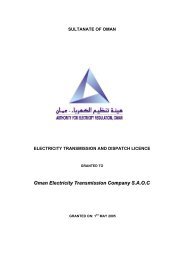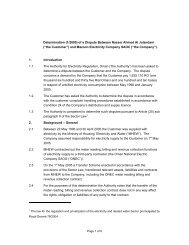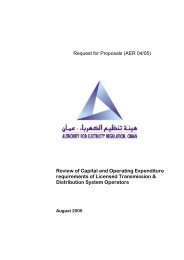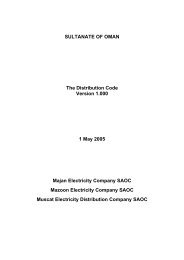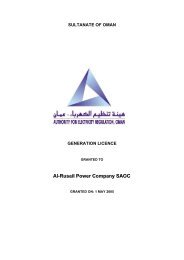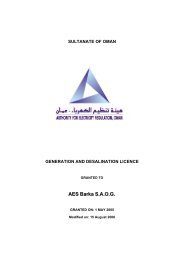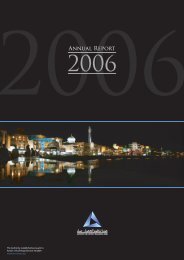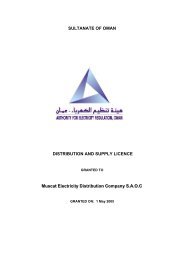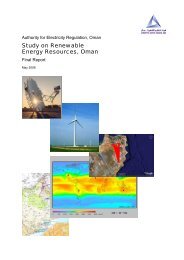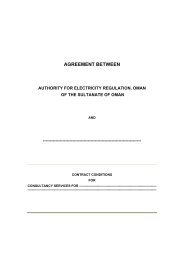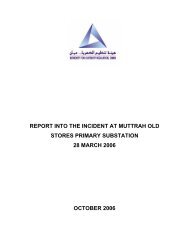GhubrahIncidentInves.. - authority for electricity regulation, oman
GhubrahIncidentInves.. - authority for electricity regulation, oman
GhubrahIncidentInves.. - authority for electricity regulation, oman
You also want an ePaper? Increase the reach of your titles
YUMPU automatically turns print PDFs into web optimized ePapers that Google loves.
Report Number: R 8991<br />
Issue: 1.1<br />
3 PROCESS<br />
Hypochlorite is used during the desalination process to control bacterial growth<br />
within the system. Hydrogen is a by-product of the process. The Hypochlorite<br />
treatment process separates the majority of the hydrogen in separators prior to being<br />
pumped into the hypochlorite storage cylinder. Each cylinder is allowed to vent to<br />
atmosphere, and to assist the ventilation process, three fans, two running and one in<br />
standby are used, common to the four cylinders. Although the majority of the<br />
hydrogen is separated, prior to storage, there still remains a ‘trace’ level. The ‘D’<br />
hypochlorite cylinder was reportedly 80% full (liquid) allowing the remaining head<br />
space to fill with hydrogen separated from the hypochlorite be<strong>for</strong>e venting to<br />
atmosphere. Note, the cylinders vent to atmosphere and are there<strong>for</strong>e not classed as<br />
pressurised vessels.<br />
4 PROBABLE CAUSE<br />
4.1 Inadequate Permit to Work considerations<br />
Permit PTW / LOA No. 10795/L does not state whether it is a hot or cold permit to<br />
work, neither box is ticked. However, the wording on the permit indicates that it was<br />
considered to be a ‘cold’ PTW covering the cylinder painting activity only. Under a<br />
‘cold’ permit to work the painters contacted mechanical maintenance to assess and /<br />
or replace the hooding on the four hypochlorite cylinders. Work order No. LO<br />
42/04/06 was issued and progressed <strong>for</strong> Tanks A, B and D with reference to LOA<br />
No. 10795/L with no Risk Assessment evident. Repair maintenance to Cylinder ‘C’<br />
was completed without incident under a separate Work Order LO 37/03/06 (not<br />
included). During the maintenance activities on the ‘D’ cylinder the two maintenance<br />
fitters were using an electric drill in proximity to the cylinder vent, where the<br />
probability of hydrogen gas being present should have been considered to be the<br />
norm, and there<strong>for</strong>e a significant risk to health and safety given the work involving a<br />
potential source of ignition.<br />
4.2 Probable source of ignition<br />
The electric drill being used at the time of the incident was of a standard ‘DIY’ type<br />
with the original plug removed and ‘taped’ to extension cord with a 13 amp, standard<br />
3-pin domestic plug. The plug was inserted into an extension lead drum (still coiled<br />
(not good practice)) with an industrial plug fitted. An electric drill will always issue<br />
sparks from the brushes and in all probability a spark from the drill brushes (or at<br />
least, some similar <strong>for</strong>m of ignition) ignited the hydrogen gas venting from the<br />
hypochlorite tank which caused the hydrogen within the cylinder to explode (gas was<br />
under the constraints of the cylinder) and hence a ‘fire ball’ issued from the vent<br />
causing the fatal injuries to the two maintenance fitters.<br />
4.3 Related Observations<br />
The explosion was of sufficient <strong>for</strong>ce to lift the entire cylinder c. 100mm from its<br />
anchoring bolts and snap a 200mm drainage pipe with pipe wall thickness of c.<br />
12mm.<br />
Page 6 / 11



